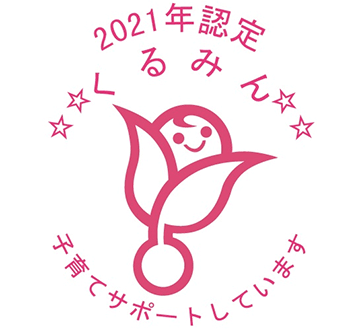Since FY2019, Nissui has implemented a Teleworking System. In April 2021, the maximum number of full telework days allowed was raised to three days per week. In January 2022, as part of efforts to create an environment where diverse talent can thrive, a system was introduced allowing employees managing both work and family responsibilities, such as child-raising or caregiving, to work exclusively through telework as a general rule, without being subject to the weekly cap on teleworking days.
In addition to the Teleworking System, the introduction of satellite offices has expanded workplace options, encouraging flexible work styles free from time and location constraints.
![[Photo] Office-wide Teleworking Day at Nissui’s Head Office](/assets/img/site/147/147_52_img-01.jpg)
Office-Wide Teleworking Day at Nissui’s Head Office
As part of creating a comfortable and rewarding workplace, Nissui has introduced company-wide targets for leave utilization rates and recommended leave days to encourage planned leave-taking. In response to employee requests to reserve regular leave for emergency sick leave, “Anshin Leave” (Short-term Paid Leave for Non-occupational Injuries and Diseases) was introduced in FY2019 as a separate system from standard leave.
From FY2023, Nissui expanded its leave programs by adding two new paid leave days annually for all employees, in addition to the existing accumulated leave system. These initiatives aim to create leave systems that support employees' physical and mental well-being while fostering a sense of purpose and satisfaction in their work.
Scope: Nissui Corporation (As of the end of March of each year)
Note: Beginning in FY2024, the scope of aggregation has been revised to include only annual paid leave, with paid leave taken for specific reasons excluded from the calculation.
We recognize balancing childcare as one of the greatest challenges for long-term career growth. To address this, Nissui is taking steps to reduce anxiety about career progression before and after returning from childcare leave. We support a smooth transition back to work and future career growth through initiatives such as introducing career discussions between female employees on childcare leave and their supervisors using “Interview Sheets for Employees Returning to Work from Maternity and Childcare Leave” and actively promoting the use of these interview sheets for male employees who take extended childcare leave, an initiative that began with our efforts to encourage paternity leave. In particular, the support provided not only before childbirth and at the time of returning to work, but also on an ongoing basis after returning to work, has been well received. In addition, we provide department heads with employees who are raising children with the information necessary for managing such team members, and by doing so, encourage management-led support for employees’ return to work.
Furthermore, as measures to support the balance between work and childcare, we are also working to improve the work environment and to foster networking among employees who are raising children through initiatives such as the introduction of babysitter discount vouchers and the holding of “networking events for employees who are raising children and employees preparing to do so.”
Nissui has been formulating action plans based on the Act on Advancement of Measures to Support Raising Next-Generation Children since 2005 and in May 2010, it received the "Kurumin" Mark Certification from the Minister of Health, Labour and Welfare, which is awarded to companies that support child-rearing.
In FY2021, for the fourth time in a row, Nissui received the ‘Kurumin 4 Star’ certification. At the present time, Nissui is engaged in initiatives to achieve the goals of our Sixth Phase Action Plan. Nissui is committed to introducing various measures to be a company in which both men and women are able to balance their work with childcare.
(note) “Kurumin” mark: Companies and national/local governments are mandated by the Act on Advancement of Measures to Support Raising Next-Generation Children to formulate an action plan to support the healthy birth and growth of children, who will be shaping our society for the next generation. It is a certification mark awarded to companies that have achieved the targets set in their action plans and met certain standards.

Next-Generation Mark
(Nickname: “Kurumin”)
Nissui aims to create an environment where both men and women can continue working while raising children and pursue positive career development. As part of creating a worker-friendly workplace, the company has set a target of achieving a 100% childcare leave utilization rate. For male employees who have become fathers, Nissui actively encourages taking childcare leave, confirms their intentions regarding leave, and promotes understanding among department heads to facilitate childcare leave utilization across all workplaces.
As a result, the male childcare leave utilization rate was 106.7% in FY2024 (110.0% in FY2023). Nissui remains committed to fostering an environment where both men and women can take leave with confidence and peace of mind.
As of March of each year
Scope: Nissui Corporation
Cité Marine S.A.S. (France), a member of the Nissui Group, set up a nursery in October 2020, for the purpose of creating an environment that is pleasant to work in even while employees are raising children; 20 children of employees go to the nursery.

Nissui has a nursing care leave program, in which 10 days of leave per year is allowed to employees with one person in their care, and 20 days per year for employees with two persons or more in their care. In addition to hosting nursing care seminars led by expert instructors, Nissui has contracted specialized nursing care agencies to offer consultation desks where employees can receive free advice via phone and email. Settings are also established for employees to discuss the use of nursing care services among those facing similar challenges. Furthermore, Nissui supports employees dealing with nursing care by recommending the use of flexible work arrangements such as “Coreless Flex,” and by including nursing care as one of the criteria for eligibility for full-time work from home. Assistance with nursing care costs is also provided through the cafeteria plan options. Through these initiatives, Nissui is cultivating a culture in which both the individuals directly involved and their supervisors and colleagues treat each nursing care issue as their own personal concern, thereby creating a supportive environment that recognizes the unique aspects of each situation.
| Reason | System | Description |
|---|---|---|
| Childcare | Leave for preparing for childbirth | An employee can take leave on a full-day or half-day basis for up to 15 days while the employee or the employee’s spouse is pregnant until two weeks after the birth of a child. Both male and female employees can take leave at times of poor physical condition (e.g., nausea of pregnancy) and when undergoing medical examination, etc., including accompanying their partners. An employee can take leave out of his/her accrued leave. |
| Childcare | Childcare leave | Childcare leave can be taken by male employees as well, and is treated as paid leave for up to five days. |
| Childcare | Leave for childbirth by spouse | An employee can take special paid leave for up to two days in cases where his spouse has given birth to a child. |
| Childcare | Leave for taking care of sick children | In cases where an employee has to take care of his/her child of primary school age or younger due to injury or illness, or in cases where an employee has to make such child receive a vaccination or undergo health examination, he/she can take leave on an hourly basis for up to five days in the case of one child or up to ten days in the case of two or more children. An employee can take leave out of his/her accrued leave. |
| Childcare | Babysitter discount voucher | A subsidy program that allows employees with infants or children up to the third grade of elementary school (or up to the sixth grade in some cases) to receive a discount of up to 4,400 yen per day (equivalent to two vouchers) per child for babysitting services. |
| Childcare | Shortened-workday system | An employee can use this system for a maximum of seven years in total, including childcare leave, until his/her child completes the third year of primary school. An employee can also use the shortened-flextime system. |
| Nursing care | Nursing care leave | An employee can take leave on an hourly basis for up to 10 days in the case of one person in his/her care or up to 20 days in the case of two or more persons in his/her care. An employee can take leave out of his/her accrued leave. |
| Nursing care | Extended nursing care leave | An employee can take extended nursing care leave multiple times for a total of up to one year and six months per eligible family member in his/her care. |
| Nursing care | Shortened-workday system | An employee can use this system for a maximum of three years per person in his/her care. An employee can also use the shortened-flextime system. |
| Universal | Flextime system | Applicable to employees other than some employees, such as plant workers. |
| Universal | Teleworking System | Applicable to all employees other than some employees, such as plant workers. This system can be used on the grounds of making operations more efficient, promoting health and welfare, and striking a balance between work and family. Telework, which means working without attending the workplace, is capped at three times per week. |
| Universal | "Anshin" Leave (Short-term Paid Leave for Non-occupational Injuries and Diseases) | Each fiscal year, an employee is granted five days of paid leave that can be taken when he/she has suffered short-term non-occupational injury or illness (e.g., cold) and has difficulty coming to work. |
| Universal | Refreshment leave | An employee is entitled to take leave for five consecutive days when the length of his/her service has reached 10, 20 or 30 years. Such an employee is also paid a grant. |
| Universal | Coreless flex | Core hours in the flextime system were abolished, and the start time of work was also pushed back to 5:00 onwards. |
| Universal | Taking paid leave on an hourly basis | All employees can take paid leave not only on a full-day basis and half-day basis but also on an hourly basis for up to five days per year. Employees can take hourly leave at the beginning of the workday, mid-day (once per day) and at the end of the workday. |